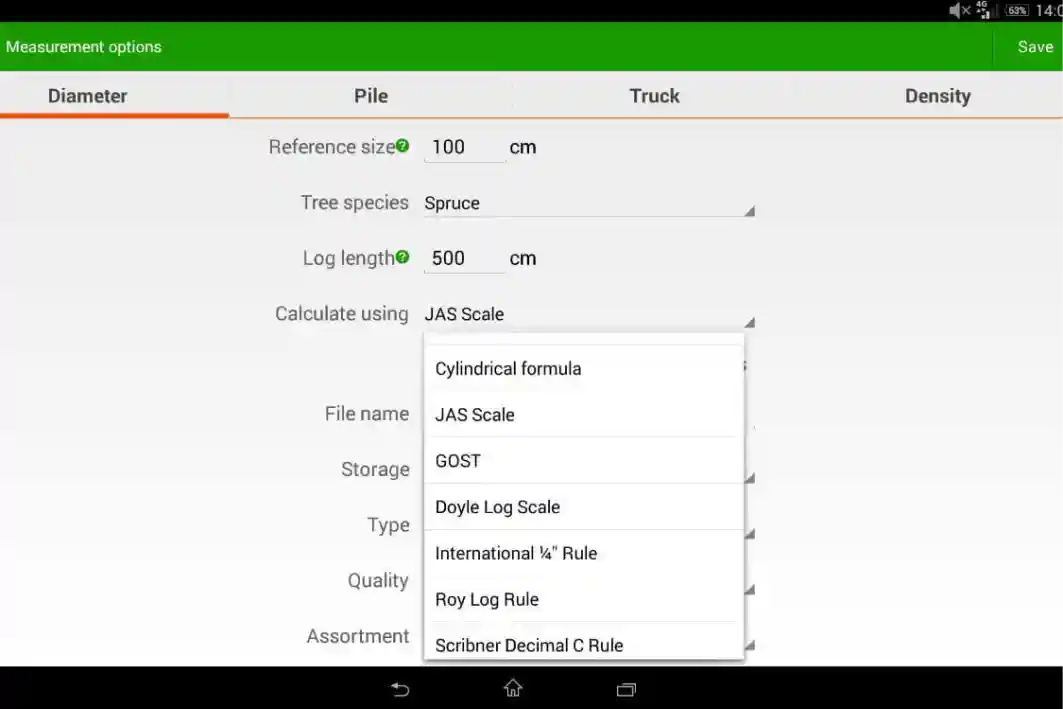There are a variety of log scaling methods around the world. However, there is a vast variability between each region, making transparent communication difficult. Describing each method and its parameters are vital for enabling clear and transparent measurement between all partners, and thus eradicating any attempts at fraud.
Typically, each method utilizes length and diameter information to determine volume in cubic units. Several log-scaling methods require small-end diameter measurement while others require diameters at both ends of the log. The majority of methods use the diameter measurement under the bark.
Some methods are based on mathematical formulas (JAS; Doyle to name two) and others use fixed values for certain diameters that come from tables (GOST).
A very important part of the log volume calculation is rounding the diameter. While many of the formulas use the conservative mathematical rounding (meaning 25.5cm 26cm and 25.4 25cm), for example, the Japanese Agricultural Standard requires rounding down to the nearest even number (meaning 25.9cm is rounded down to 24). This, of course, raises questions about the log’s true volume – but these are the rules that must be abided by.
For the Timbeter team, this was puzzling when applying the rounding rules, because our solution shows diameters with mm accuracy.
Timbeter has the following formulas inside the application:
- Cylindrical formula
- JAS Scale
- GOST 2708-75
- Doyle Log Scale
- International 1/4″ Rule
- Roy Log Rule
- Scribner Decimal C Rule
- Ontario Scaler’s Rule
- Nilson (Estonian formula)
- Lithuanian formula

JAS scale (Japan, Chile, East Asia, Oceania, Australia)
For logs less than 6m long:
V(m3) = (D²*L)/10000
where:
D – small-end diameter(cm), for less than 14cm the diameter is rounded down and after 14cm the diameter is rounded down to the nearest even integer.
L – Length(m)
For logs equal to or greater than 6m:
V(m3) = (D + [L’-4]/2)^2*(L/10000)
D – small-end diameter(cm), for less than 14cm the diameter is rounded down and after 14cm the diameter is rounded down to the nearest even integer.
L – Length(m)
L’ – length in meters rounded down to nearest whole number
Doyle Log formula (central and eastern North America)
bf volume= (small-end diameter in inches – 4)² x length / 16, round to the nearest bf
International 1/4″ Rule (eastern North America)
FBM = (0.199 x diameter in inches²) – (0.642 x diameter in inches);
Standardized taper of 0.125“ is used to calculate log segments. Each segment consists of 4′ cylinders and the result of the segment is rounded to the nearest 5 FBM (157.3 ~ 155 FBM, etc.)
Ontario Scaler’s Rule
(D² * 0.7854 * L) / 10000 = m^3 rounded to 3 decimal places
D – small-end diameter in 2 centimeter classes (even integer) (ex. 15.01cm ~ 16cm, 14.99cm~14cm)
L – Length in meters
Scribner Decimal C Rule (Western USA)
(0.79*D² – 2D – 4) * L/16 = FBM rounded to the nearest 10 FBM (313 ~ 310, 317 ~ 320 etc.)
D – small-end diameter in inches, rounding half down if the diameter is exactly .5
L – Length in feet
Nilson (Estonia)
cbm = (d² * L*(a1+a2*L)+a3*L²)/10 000
d – small-end diameter
L – Length in dm
a1, a2, a3 – coefficients, that are defined by the tree species.
For Pine a1= 0.0799, a2=0.000146, a3=0.0411
For Spruce a1= 0.07995, a2=0.00016105, a3=0.04948
For Birch and other Hardwoods a1=0.0783, a2=0.000236, a3=0.045
For other Conifers a1=0.0800, a2=0.000154, a3=0.0453
The Lithuanian formula and the GOST 2708-75 formula for volume calculation are based on tables.
For cases where timber has been stacked with both the ends mixed, we suggest using the Cylindrical (also known as “True content of cylinder”) formula, which is also available in Timbeter. This is the dominant method used in most of continental Europe.
Most of the formulae listed in this article originate from Matthew A. Fonseca’s book, the author of “The Measurement of Roundwood”. Our team had the honor to meet him at the Timber Measurement Society Annual Meeting in Coeur d`Alene last year. I agree with him that log scaling needs to be simplified, unified and harmonized. This industry needs to change in order to become more transparent and effective. Using Timbeter is the way to begin increased transparency and ease to business.
